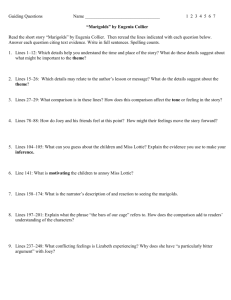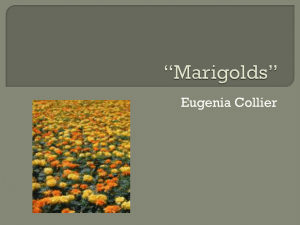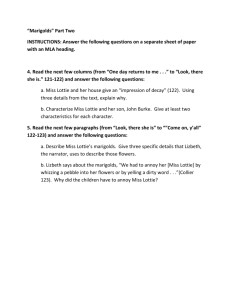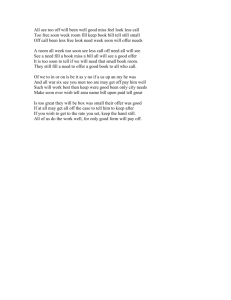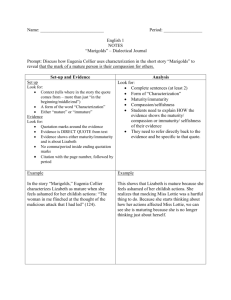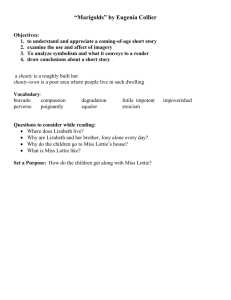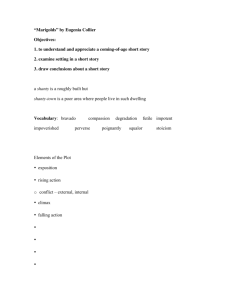A Close Read and After Reading Questions
advertisement
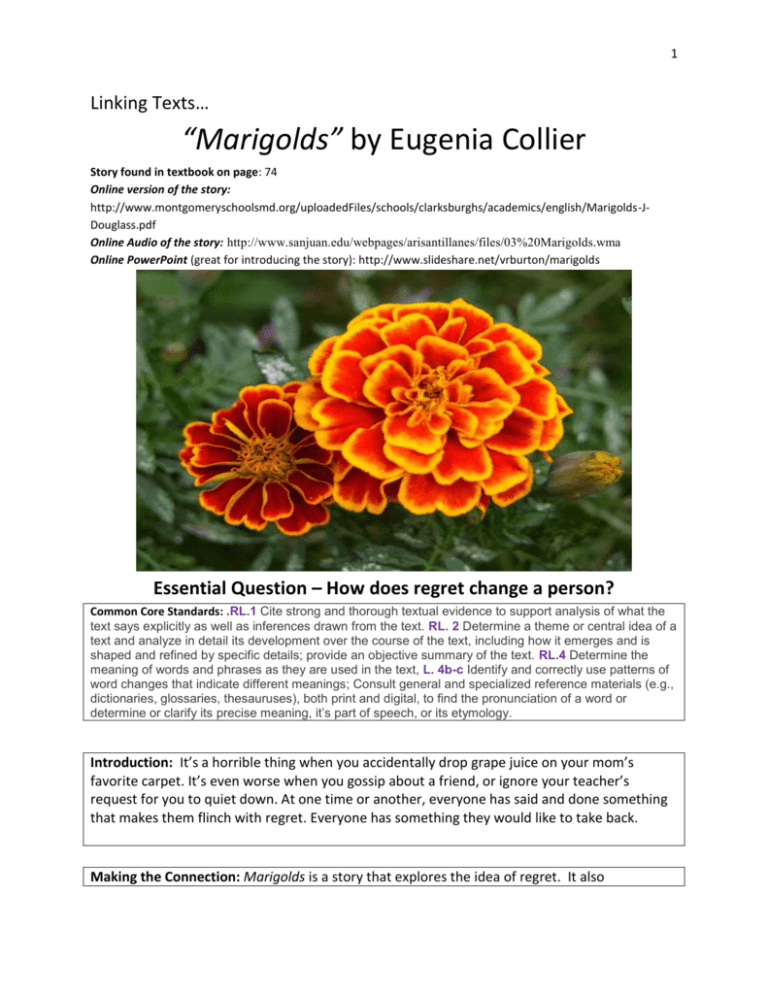
1 Linking Texts… “Marigolds” by Eugenia Collier Story found in textbook on page: 74 Online version of the story: http://www.montgomeryschoolsmd.org/uploadedFiles/schools/clarksburghs/academics/english/Marigolds-JDouglass.pdf Online Audio of the story: http://www.sanjuan.edu/webpages/arisantillanes/files/03%20Marigolds.wma Online PowerPoint (great for introducing the story): http://www.slideshare.net/vrburton/marigolds Essential Question – How does regret change a person? Common Core Standards: .RL.1 Cite strong and thorough textual evidence to support analysis of what the text says explicitly as well as inferences drawn from the text. RL. 2 Determine a theme or central idea of a text and analyze in detail its development over the course of the text, including how it emerges and is shaped and refined by specific details; provide an objective summary of the text. RL.4 Determine the meaning of words and phrases as they are used in the text, L. 4b-c Identify and correctly use patterns of word changes that indicate different meanings; Consult general and specialized reference materials (e.g., dictionaries, glossaries, thesauruses), both print and digital, to find the pronunciation of a word or determine or clarify its precise meaning, it’s part of speech, or its etymology. Introduction: It’s a horrible thing when you accidentally drop grape juice on your mom’s favorite carpet. It’s even worse when you gossip about a friend, or ignore your teacher’s request for you to quiet down. At one time or another, everyone has said and done something that makes them flinch with regret. Everyone has something they would like to take back. Making the Connection: Marigolds is a story that explores the idea of regret. It also 2 investigates concepts such as vanity, beauty, and poverty. After you finished reading Marigolds, you will explore nonfiction texts and visuals that are also about the same topics. Evaluating the text: The story Marigolds takes place in rural African-American community during the 1930’s. This was a time of intense racial segregation, poverty, and restrained opportunity. Most African-Americans faced hard times and extreme poverty. During the Great Depression all Americans were suffering financially; however, African-Americans were particularly hard hit. The setting is crucial to determining the stories theme. As you read, think about the role the setting plays, and how it influences the narrator’s experiences and the problems she must deal with and overcome. The setting offers important clues about the development of the stories theme, or central message. For instance, the figurative, or nonliteral, description of “futile waiting” as “the sorrowful background music of our impoverished little community” powerfully describes the setting and hints at the hopelessness of the narrator’s circumstances. While you read, think about how the setting influences the narrator’s experiences and the challenges she confronts. What message do those experiences teach readers about life? How does it lead the reader to the story’s theme? Skills for Reading: Coming to a Conclusions A conclusion is a logical judgment founded on information in the text and on your own experiences and prior knowledge. While reading “Marigolds,” keep track of your thoughts by creating a graphic organizer like the one below (which also includes an example). After that, you can practice coming to a conclusion. Student Example: Text Information All the narrator remembers about her hometown is dust. Prior Knowledge My Conclusion Many people usually can remember something nice or happy about their childhoods The narrator had a difficult childhood because she can’t remember anything happy about it. Vocabulary in Context Fill out the chart below, using these words from the story: bravado, degradation, exuberance, futile, impotent, nostalgia, ostensibly, perverse, poignantly, retribution, squalor, stoicism I know this word well I’ve heard of this word/ I know something about this word I don’t know this word at all 3 About the Author Eugenia Collier was born in raised in the highly segregated city of Baltimore, Maryland. Her parents were educated professionals and instilled the importance of education in her from an early age. She earned degrees at both Howard University, and later at Columbia. She worked as a case carrier in Baltimore, and later became a college professor and began her writing career. She credits her African-American heritage as her inspiration for her stories. Marigolds by Eugenia Collier (story also found in textbook on page 74) View this picture of the Marigold. What mood does it evoke? Explain. A Close Reading Exercise When I think of the hometown of my youth, all that I seem to remember is dust—the brown, crumbly dust of late summer—arid, sterile dust that gets into the eyes and makes them water, gets into the throat and between the toes of bare brown feet. I don’t know why I should remember only the dust. Surely there must have been lush green lawns and paved streets under leafy shade trees somewhere in town; but memory is an abstract painting—it does not present things as they are, but rather as they feel. And so, when I think of that time and that place, I remember What details in the first passage allow the reader to visualize the setting? Explain. What point of view is this story being told in? How do you know? 4 only the dry September of the dirt roads and grassless yards of the shantytown where I lived. And one other thing I remember, another incongruency of memory—a brilliant splash of sunny yellow against the dust—Miss Lottie’s marigolds. Whenever the memory of those marigolds flashes across my mind, a strange nostalgia comes with it and remains long after the picture has faded. I feel again the chaotic emotions of adolescence, illusive as smoke, yet as real as the potted geranium before me now. Joy and rage and wild animal gladness and shame become tangled together in the multicolored skein of fourteen-going-on-fifteen as I recall that devastating moment when I was suddenly more woman than child, years ago in Miss Lottie’s yard. I think of those marigolds at the strangest times; I remember them vividly now as I desperately pass away the time. I suppose that futile waiting was the sorrowful background music of our impoverished little community when I was young. The Depression that gripped the nation was no new thing to us, for the black workers of rural Maryland had always been depressed. I don’t know what it was that we were waiting for; certainly not for the prosperity that was “just around the corner,” for those were white folks’ words, which we never believed. Nor did we wait for hard work and thrift to pay off in shining success, as the American Dream promised, for we knew better than that, too. Perhaps we waited for a miracle, amorphous in concept but necessary if one were to have the grit to rise before dawn each day and labor in the white man’s vineyard until after dark, or to wander about in the September dust offering one’s sweat in return for some meager share of bread. But God was chary with miracles in those days, and so we waited—and waited. We children, of course were only vaguely aware of the extent of our poverty. Having no radios, somewhat unaware of the world outside our community. Nowadays we would be called culturally deprived and people would write books and hold conferences about us. In those days everybody we knew was just as hungry and ill clad as we were. Poverty was the cage in which we all were trapped, and our hatred of it was still the vague, undirected restlessness of the zoo-bred flamingo who knows that nature created him to fly free. As I think of those days I feel most poignantly the tag end of summer, the bright, dry times when we began to have a sense of shortening days and the imminence of the cold. By the time I was fourteen, my brother Joey and I were the only children left at our house, the older ones having left home for early marriage or the lure of the city, and the two babies having been sent to relatives who might care for them better than we. Joey What words in the first three paragraphs are you unfamiliar with? Circle them and find out what they mean using a dictionary. What does the narrator mean when she says, “ I suppose that futile waiting was the sorrowful background music of our impoverished little community when I was young.” What is the American Dream? Does our narrator believe that it is a dream attainable by her community members? Which motto would the members of the narrator’s community more likely to believe in: Hard work equals success or wait for a miracle? Explain your answer. Reread the highlighted portion of this paragraph and rewrite it in your own words. 5 was three years younger than I, and a boy, and therefore vastly inferior. Each morning our mother and father trudged wearily down the dirt road and around the bend, she to her domestic job, he to his daily unsuccessful quest for work. After our few chores around the tumbledown shanty, Joey and I were free to run wild in the sun with other children similarly situated. For the most part, those days are ill-defined in my memory, running together and combining like a fresh watercolor painting left out in the rain. I remember squatting in the road drawing a picture in the dust, a picture which Joey gleefully erased with one sweep of his dirty foot. I remember fishing for minnows in a muddy creek and watching sadly as they eluded my cupped hands, while Joey laughed uproariously. And I remember, that year, a strange restlessness of body and of spirit, a feeling that something old and familiar was ending, and something unknown and therefore terrifying was beginning. One day returns to me with special clarity for some reason, perhaps because it was the beginning of the experience that in some inexplicable way marked the end of innocence. I was loafing under the great oak tree in our yard, deep in some reverie which I have now forgotten, except that it involved some secret, secret thoughts of one of the Harris boys across the yard. Joey and a bunch of kids were bored now with the old tire suspended from an oak limb, which had kept them entertained for a while. “Hey, Lizabeth,” Joey yelled. He never talked when he could yell. “Hey, Lizabeth, let’s go somewhere.” I came reluctantly from my private world. “Where you want to go? What you want to do?” The truth was that we were becoming tired of the formlessness of our summer days. The idleness whose prospect had seemed so beautiful during the busy days of spring now had degenerated to an almost desperate effort to fill up the empty midday hours. “Let’s go see can we find some locusts on the hill,” someone suggested. Joey was scornful. “Ain’t no more locusts there. Y’all got ‘em all while they was still green.” The argument that followed was brief and not really worth the effort. Hunting locust trees wasn’t fun anymore by now. “Tell you what,” said Joey finally, his eyes sparkling. “Let’s us go over to Miss Lottie’s.” The idea caught on at once, for annoying Miss Lottie was always fun. I was still child enough to scamper along with the group over rickety fences and through bushes that tore our already raggedy clothes, back to where Miss Lottie lived. I think now that we must have made a tragicomic spectacle, five or six kids of different ages, each of us clad in only one Based on what you have read so far, what can readers infer about the narrator’s life? Explain using details. Theme: Reread the highlighted portion of the paragraph. In your own words, what is the author saying? Common Core L4b: Language alert! Derivations Words that are created from another word or base are derivations. The word generate meaning, “to bring into existence” has many derivations, including generation and regenerate. Reread the highlighted passage and locate another derivation of generate. Based on how the word is used in context, what does it mean? 6 garment—the girls in faded dresses that were too long or too short, the boys in patchy pants, their sweaty brown chests gleaming in the hot sun. A little cloud of dust followed our thin legs and bare feet as we tramped over the barren land. When Miss Lottie’s house came into view we stopped, ostensibly to plan our strategy, but actually to reinforce our courage. Miss Lottie’s house was the most ramshackle of all our ramshackle homes. The sun and rain had long since faded its rickety frame siding from white to a sullen gray. The boards themselves seemed to remain upright not from being nailed together but rather from leaning together, like a house that a child might have constructed from cards. A brisk wind might have blown it down, and the fact that it was still standing implied a kind of enchantment that was stronger than the elements. There it stood and as far as I know is standing yet—a gray, rotting thing with no porch, no shutters, no steps, set on a cramped lot with no grass, not even any weeds—a monument to decay. In front of the house in a squeaky rocking chair sat Miss Lottie’s son, John Burke, completing the impression of decay. John Burke was what was known as queer-headed. Black and ageless, he sat rocking day in and day out in a mindless stupor, lulled by the monotonous squeak-squawk of the chair. A battered hat atop his shaggy head shaded him from the sun. Usually John Burke was totally unaware of everything outside his quiet dream world. But if you disturbed him, if you intruded upon his fantasies, he would become enraged, strike out at you, and curse at you in some strange enchanted language which only he could understand. We children made a game of thinking of ways to disturb John Burke and then to elude his violent retribution. Based on the description of Miss Lottie’s house, what can readers infer about her financial and social standing? Explain using details. What details in this paragraph help the reader to understand John Burke? Analyze this visual – Does it match what you pictured John Burke looking like based on the description provided by the narrator? Why or why not? But our real fun and our real fear lay in Miss Lottie herself. Miss Lottie seemed to be at least a hundred years old. Her big frame still held traces of the tall, powerful woman she must have been in youth, 7 although it was now bent and drawn. Her smooth skin was a dark reddish brown, and her face had Indian-like features and the stern stoicism that one associates with Indian faces. Miss Lottie didn’t like intruders either, especially children. She never left her yard, and nobody ever visited her. We never knew how she managed those necessities which depend on human interaction—how she ate, for example, or even whether she ate. When we were tiny children, we thought Miss Lottie was a witch and we made up tales that we half believed ourselves about her exploits. We were far too sophisticated now, of course, to believe the witch nonsense. But old fears have a way of clinging like cobwebs, and so when we sighted the tumbledown shack, we had to stop to reinforce our nerves. “Look, there she is,” I whispered, forgetting that Miss Lottie could not possibly have heard me from that distance. “She’s fooling with them crazy flowers.” “Yeh, look at ‘er.” Miss Lottie’s marigolds were perhaps the strangest part of the picture. Certainly they did not fit in with the crumbling decay of the rest of her yard. Beyond the dusty brown yard, in front of the sorry gray house, rose suddenly and shockingly a dazzling strip of bright blossoms, clumped together in enormous mounds, warm and passionate and sun-golden. The old black witch-woman worked on them all summer, every summer, down on her creaky knees, weeding and cultivating and arranging, while the house crumbled and John Burke rocked. For some perverse reason, we children hated those marigolds. They interfered with the perfect ugliness of the place; they were too beautiful; they said too much that we could not understand; they did not make sense. There was something in the vigor with which the old woman destroyed the weeds that intimidated us. It should have been a comical sight—the old woman with the man’s hat on her cropped white head, leaning over the bright mounds, her big backside in the air—but it wasn’t comical, it was something we could not name. Theme and Setting: How does Miss Lottie feel about the Marigolds? Explain. Theme and Setting: Reread this quote- “For some perverse reason, we children hated those marigolds. They interfered with the perfect ugliness of the place; they were too beautiful; they said too much that we could not understand; they did not make sense.” In your own words, why did the children hate the marigolds? Why didn’t they “make sense?” Analyze Visuals – How does this painting compare to the description of Miss 8 Lottie? Explain your answer. We had to annoy her by whizzing a pebble into her flowers or by yelling a dirty word, then dancing away from her rage, reveling in our youth and mocking her age. Actually, I think it was the flowers we wanted to destroy, but nobody had the nerve to try it, not even Joey, who was usually fool enough to try anything. “Y’all git some stones,” commanded Joey now and was met with instant giggling obedience as everyone except me began to gather pebbles from the dusty ground. “Come on, Lizabeth.” I just stood there peering through the bushes, torn between wanting to join the fun and feeling that it was all a bit silly. “You scared, Lizabeth?” I cursed and spat on the ground—my favorite gesture of phony bravado. “Y’all children get the stones, I’ll show you how to use ‘em.” I said before that we children were not consciously aware of how thick were the bars of our cage. I wonder now, though, whether we were not more aware of it than I thought. Perhaps we had some dim notion of what we were, and how little chance we had of being anything else. Otherwise, why would we have been so preoccupied with destruction? Anyway, the pebbles were collected quickly, and everybody looked at me to begin the fun. “Come on, y’all.” We crept to the edge of the bushes that bordered the narrow road in front of Miss Lottie’s place. She was working placidly, kneeling over the flowers, her dark hand plunged into the golden mound. Suddenly zing—an expertly aimed stone cut the head off one of the blossoms. “Who out there?” Miss Lottie’s backside came down and her head came up as her sharp eyes searched the bushes. “You better git!” Based on the narrator’s actions in the highlighted portion, what can readers infer about her? Theme and Setting: What connections are made between poverty described in the metaphor of the cage, and the destruction of the marigolds? How does Miss Lottie react to the children’s destruction of her marigolds? How do you know? Common Core L4c 9 We had crouched down out of sight in the bushes, where we stifled the giggles that insisted on coming. Miss Lottie gazed warily across the road for a moment, then cautiously returned to her weeding. Zing—Joey sent a pebble into the blooms, and another marigold was beheaded. Miss Lottie was enraged now. She began struggling to her feet, leaning on a rickety cane and shouting. “Y’all git! Go on home!” Then the rest of the kids let loose with their pebbles, storming the flowers and laughing wildly and senselessly at Miss Lottie’s impotent rage. She shook her stick at us and started shakily toward the road crying, “Git ‘long! John Burke! John Burke, come help!” Then I lost my head entirely, mad with the power of inciting such rage, and ran out of the bushes in the storm of pebbles, straight toward Miss Lottie, chanting madly, “Old witch, fell in a ditch, picked up a penny and thought she was rich!” The children screamed with delight, dropped their pebbles, and joined the crazy dance, swarming around Miss Lottie like bees and chanting, “Old lady witch!” while she screamed curses at us. The madness lasted only a moment, for John Burke, startled at last, lurched out of his chair, and we dashed for the bushes just as Miss Lottie’s cane went whizzing at my head. I did not join the merriment when the kids gathered again under the oak in our bare yard. Suddenly I was ashamed, and I did not like being ashamed. The child in me sulked and said it was all in fun, but the woman in me flinched at the thought of the malicious attack that I had led. The mood lasted all afternoon. When we ate the beans and rice that was supper that night, I did not notice my father’s silence, for he was always silent these days, nor did I notice my mother’s absence, for she always worked until well into evening. Joey and I had a particularly bitter argument after supper; his exuberance got on my nerves. Finally I stretched out upon the pallet in the room we shared and fell into a fitful doze. When I awoke, somewhere in the middle of the night, my mother had returned, and I vaguely listened to the conversation that was audible through the thin walls that separated our rooms. At first I heard no words, only voices. My mother’s voice was like a cool, dark room in summer—peaceful, soothing, quiet. I loved to listen to it; it made things seem all right somehow. But my father’s voice cut through hers, shattering the peace. “Twenty-two years, Maybelle, twenty-two years,” he was saying, “and I got nothing for you, nothing, nothing.” “It’s all right, honey, you’ll get something. Everybody out of work now, you know that.” “It ain’t right. Ain’t no man ought to eat his woman’s food year in and year out, and see his Language Alert –Etymology The Latin word malus means “bad”. Words that derive from the word malus include verbs like malfunction (“fail to work properly”) and malign (“speak badly of’) What adjective in line 190 shares this etymology, or origin? What other words can you think of that also come from malus? Check a dictionary to see how many you have identified correctly. Unlike the other children, the narrator is not happy about what they have done to Miss Lottie’s precious marigolds. What does this tell the reader about her? Explain. How does the narrator feel when she listens to her mother speak? How do you 10 children running wild. Ain’t nothing right about that.” “Honey, you took good care of us when you had it. Ain’t nobody got nothing nowadays.” “I ain’t talking about nobody else, I’m talking about me. God knows I try.” My mother said something I could not hear, and my father cried out louder, “What must a man do, tell me that?” “Look, we ain’t starving. I git paid every week, and Mrs. Ellis is real nice about giving me things. She gonna let me have Mr. Ellis’s old d coat for you this winter—” “Damn Mr. Ellis’s coat! And damn his money! You think I want white folks’ leavings? “Damn, Maybelle”—and suddenly he sobbed, loudly and painfully, and cried helplessly and hopelessly in the dark night. I had never heard a man cry before. I did not know men ever cried. I covered my ears with my hands but could not cut off the sound of my father’s harsh, painful, despairing sobs. My father was a strong man who could whisk a child upon his shoulders and go singing through the house. My father whittled toys for us, and laughed so loud that the great oak seemed to laugh with him, and taught us how to fish and hunt rabbits. How could it be that my father was crying? But the sobs went on, unstifled, finally quieting until I could hear my mother’s voice, deep and rich, humming softly as she used to hum to a frightened child. The world had lost its boundary lines. My mother, who was small and soft, was now the strength of the family; my father, who was the rock on which the family had been built, was sobbing like the tiniest child. Everything was suddenly out of tune, like a broken accordion. Where did I fit into this crazy picture? I do not now remember my thoughts, only a feeling of great bewilderment and fear. Long after the sobbing and humming had stopped, I lay on the pallet, still as stone with my hands over my ears, wishing that I too could cry and be comforted. The night was silent now except for the sound of the crickets and of Joey’s soft breathing. But the room was too crowded with fear to allow me to sleep, and finally, feeling the terrible aloneness of 4 A.M., I decided to awaken Joey. “Ouch! What’s the matter with you? What you want?” he demanded disagreeably when I had pinched know? Making Conclusions: Why is the narrator’s father crying? Theme and Setting: What affect does the conversation between her parents have on the narrator? Explain your answer using details. 11 and slapped him awake. “Come on, wake up.” “What for? Go ‘way.” I was lost for a reasonable reply. I could not say, “I’m scared and I don’t want to be alone,” so I merely said, “I’m going out. If you want to come, come on.” The promise of adventure awoke him. “Going out now? Where to, Lizabeth? What you going to do?” I was pulling my dress over my head. Until now I had not thought of going out. “Just come on,” I replied tersely. I was out the window and halfway down the road before Joey caught up with me. “Wait, Lizabeth, where you going?” I was running as if the Furies were after me, as perhaps they were—running silently and furiously until I came to where I had half known I was headed: to Miss Lottie’s yard. The half-dawn light was more eerie than complete darkness, and in it the old house was like the ruin that my world had become—foul and crumbling, a grotesque caricature. It looked haunted, but I was not afraid, because I was haunted too. “Lizabeth, you lost your mind?” panted Joey. I had indeed lost my mind, for all the smoldering emotions of that summer swelled in me and burst—the great need for my mother who was never there, the hopelessness of our poverty and degradation, the bewilderment of being neither child nor woman and yet both at once, the fear unleashed by my father’s tears. And these feelings combined in one great impulse toward destruction. “Lizabeth!” I leaped furiously into the mounds of marigolds and pulled madly, trampling and pulling and destroying the perfect yellow blooms. The fresh smell of early morning and of dew-soaked marigolds spurred me on as I went tearing and mangling and sobbing while Joey tugged my dress or my waist crying, “Lizabeth, stop, please stop!” And then I was sitting in the ruined little garden among the uprooted and ruined flowers, crying and crying, and it was too late to undo what I had done. Joey was sitting beside me, silent and frightened, not knowing what to say. Then, “Lizabeth, look!’ I opened my swollen eyes and saw in front of me a pair of large, calloused feet; my gaze lifted to the swollen legs, the age-distorted body clad in a tight cotton nightdress, and then the shadowed Indian face surrounded by stubby white hair. And there was no rage in the face now, now that the garden was destroyed and there was nothing any longer to be protected. “M-miss Lottie!” I scrambled to my feet and just stood there and stared at her, and that was the Theme and Setting: Reread the highlighted passages. Why does the narrator destroy the marigolds? How does the narrator feel after she has destroyed the marigolds? Common Core RL 4 Make a Conclusion Throughout the story the narrator talks about Miss Lottie using fairy-tale metaphors. She calls her a witch and speaks about the “enchantment” surrounding her home. In the highlighted paragraph, she finally sees Miss Lottie for who she is really is. What changes have taken place in the narrator in order to allow her to see the real Miss Lottie? Paraphrase the narrator’s 12 moment when childhood faded and womanhood began. That violent, crazy act was the last act of childhood. For as I gazed at the immobile face with the sad, weary eyes, I gazed upon a kind of reality which is hidden to childhood. The witch was no longer a witch but only a broken old woman who had dared to create beauty in the midst of ugliness and sterility. She had been born in squalor and lived in it all her life. Now at the end of that life she had nothing except a falling down hut, a wrecked body, and John Burke, the mindless son of her passion. Whatever verve there was left in her, whatever was of love and beauty and joy that had not been squeezed out by life, had been there in the marigolds she had so tenderly cared for. Of course I could not express the things that I knew about Miss Lottie as I stood there awkward and ashamed. The years have put words to the things I knew in that moment, and as I look back upon it, I know that that moment marked the end of innocence. Innocence involves an unseeing acceptance of things at face value, an ignorance of the area below the surface. In that humiliating moment I looked beyond myself and into the depths of another person. This was the beginning of compassion, and one cannot have both compassion and innocence. The years have taken me worlds away from that time and that place, from the dust and squalor of our lives, and from the bright thing that I destroyed in a blind, childish striking out at God knows what. Miss Lottie died long ago and many years have passed since I last saw her hut, completely barren at last, for despite my wild contrition she never planted marigolds again. Yet, there are times when the image of those passionate yellow mounds returns with a painful poignancy. For one does not have to be ignorant and poor to find that his life is as barren as the dusty yards of our town. And I too have planted marigolds. thoughts about innocence and compassion in the paragraph. Make a Conclusion: In your own words explain what the author is saying in these final two sentences. Post Reading Questions Common Core Standards: .RL.1 Cite strong and thorough textual evidence to support analysis of what the text says explicitly as well as inferences drawn from the text. RL. 2 Determine a theme or central idea of a text and analyze in detail its development over the course of the text, including how it emerges and is shaped and refined by specific details; provide an objective summary of the text. RL.4 Determine the meaning of words and phrases as they are used in the text, 1. Recognize– What is the age of the narrator? 2. Identify– What is strange about Miss Lottie’s marigolds? 13 3. Make Observations– What does the narrator do that she ultimately regrets? 4. The influence of setting – Think about the most pronounced features of the story’s setting and the figurative language the narrator often uses to portray them. How does the setting affect the narrator’s view on life? 5. Make Conclusions – What provokes the young narrator, Lizabeth, to demolish Miss Lottie’s marigolds? Provide evidence from the story to support your answers. 6. Evaluate Climax – What is the climax of this story? How does this turning point change the narrator? 7. Evaluate the Symbolism – What do Miss Lottie’s marigolds symbolize? In order to help you organize your thoughts, fill out the chart below. Add descriptions or details of the marigolds in the first box, and then fill in the second box with ideas that connect to the description/detail from the story. Description or details about the Connections…. marigolds from the story “…warm, passionate, and sun-golden.” “sun-golden” makes a connection to the sun, which gives life and warmth 8. Evaluate Theme – All of the characters in this story deal with the anguish and pain caused by living in poverty; however, they deal with it in very different ways. Think about the way Miss Lottie responds to her life of poverty versus the way that narrator responds. What do their responses teach the reader about living in poverty? What theme can be drawn from their responses? What other themes may also come from this story? 9. Evaluate Viewpoints – Reread and think about the narrator’s view on innocence and compassion. Do you agree with her? You may use your own life’s experiences to help support your responses. 10. Text Criticism and Social Commentary – Can “Marigolds” be thought of as a social commentary on racial segregation? Provide evidence to support your ideas 14 Linking Texts Reading for Information Sowing change Newspaper Article Many hands join to transform a barren city lot into a thriving green space for plants -- and people in North Lawndale August 31, 2003|By Donna Freedman, of the Chicago Tribune Also found @ http://articles.chicagotribune.com/2003-08-31/news/0308300161_1_north-lawndale-greeningcommittee-lawndale-project-chicago-botanic-garden 15 Common Core Standards: RI. 2 Determine a central idea of a text and analyze its development over the course of the text, including how it emerges and is shaped and refined by specific details; provide an objective summary of the text RI 3 Analyze how the author unfolds an analysis or series of ideas or events, including the order in which the points are made, how they are introduced and developed, and the connections that are drawn between them. RI. 5 Analyze in detail how an author’s ideas or claims are developed and refined. L. 4a Use context as a clue to the meaning of a word In the story “Marigolds” Miss Lottie plants the flowers because they bring her happiness. They provide her with a bright spot, and serve as source of beauty in an otherwise depressing setting. Today, it is very common to find for inner-city residents also creating gardens to serve as their own sources as beauty. Like Miss Lottie, they are looking to transform spaces from barren to beautiful. The article “Sowing Change” will explain more about. Focusing on the Common Core Standards: When reading for information, you will often need to understand and analyze a great deal of information. Outlining is a very efficient way to organize information. An outline organizes the text’s main ideas and supporting details according to their level of importance. Since the main ideas and supporting details are written in the form of brief phrases, an outline can be considered a text’s frame. A. Create an outline of the article, Sowing Change, by using the Cornell Note taking method. Start by watching the Cornell Note PowerPoint with your teacher. You can also review this PDF handout / explanation of Cornell notes found @ http://www.sandburgspartans.us/sitebuildercontent/sitebuilderfiles/CornellWay.pdf B. After you have learned about how to take excellent Cornell Notes, read the newspaper article, Sowing Change, below. Answer the question in the Close Reading as you read. 16 C. Next, you will complete a set of Cornell notes based on your understanding of the text. Use the template found @ http://www.sandburgspartans.us/sitebuildercontent/sitebuilderfiles/CornellNoteFormat.pdf to guide you as your complete your notes. Also, there is a word template of the notes on the next page. Cornell Notes Topic/Objective: Name: Class/Period: Date: Essential Question: Questions: Notes: 17 Summary: Sowing Change by Donna Freedman, of the Chicago Tribune A Close Read of Informational Text 18 Before you read, skim the entire article and see if you can decipher what the main topics and sub-topics may be. The 20-by-32-foot bed of marigolds is not just a sea of orange blooms, but a Rorschach blot. Back up a few feet, look again and the shape of the African continent emerges on a North Lawndale street corner. A pair of doorway-like arbors invites passersby off the sidewalk and into a garden where raised beds are a glory of lilies, daisies, hibiscus, nicotiana, shrub roses and other plants. In some places, flowers fight for space among broccoli, sweet potatoes and purple kale that are almost treelike in their vigor. Consider the title Sowing Change. Based what this sowing change means, what might a reader infer this article will be about? Explain. Three low, bark-covered mounds, plus a limestone-terraced hill at the rear of the site, give a sense of terrain. Shrubs, ornamental grasses and young hackberry, black locust, crab apple and magnolia trees also provide vertical uplift on this city lot. "This is what we need: open space, a place to sit and talk, to think a while," says North Lawndale resident Gerald Earles, sitting in the garden at 12th Place and Central Park Avenue. The 130-by-100-foot garden seemed to spring up in a single day in late April. In reality, it took more than two years, about 400 volunteers and $200,000 in donated materials and expertise to create the African Heritage Garden. "I've always known that the community [was] capable of a project of this magnitude. We just needed a focus," says Valerie Leonard, executive director of the non-profit North Lawndale Small Grants Human Development Corp. The corporation's attempts to garden on the site in 2001 and 2002 What was needed in order to build the garden? Common Core L4a Language Alert –Word Origins: Many botanical terms, such as the names of plants, are 19 withered and died due to a lack of water. But things finally came together this year after the Chicago Botanic Garden, NeighborSpace, a non-profit land trust, and The Enterprise Companies, a residential real estate development firm, provided financial and design support. About 200 people, including about 25 people from the community, attended a design session in March to determine what the garden would become. All agreed that the site should have a bed shaped like the African continent and incorporate a number of plants that grow in Africa. Both ideas were part of Leonard's original plan, which was inspired by Unity Park, another Lawndale project. That park was created five years ago by residents fed up with drug dealing and crime near 19th Street and Kostner Avenue. Gladys Woodson, who spearheaded that project, says that once the site became a well-used and neatly maintained park, the criminal element left. "If you get enough good people to come out, the bad people are going to leave," Woodson says. She and other Unity Park organizers are helping at the African Heritage Garden as well. In fact, the heritage garden is thriving under the care and nurturing of a variety of groups, including the North Lawndale Greening Committee, the Combined Block Club and Slumbusters. NeighborSpace, which purchased the land from the city and leases it to North Lawndale, also paid to install a water hookup. derived from Latin. Some terms, however, have their linguistic roots in other languages. Withered come from the Middle English root widren, which is related to another Middle English words meaning “weathered.” Considering this information and the context clues, what does withered mean? What is the purpose of this garden? The plants and landscape materials, design and on-site supervision were paid for by a grant from the Chicago Botanic Garden's Neighborhood Gardens program. Each year, the Chicago Botanic Garden awards money to community groups interested in greening their neighborhoods. It all came together on April 26 when about five dozen volunteers of varying ages, mostly neighborhood residents, planted hundreds of flowers and vegetable seedlings under the supervision of the Chicago Botanic Garden's Community Gardens division. The Safer Foundation, which helps men make the transition from prison to the outside world, sent clients to build arbors and a half-dozen large raised beds. With regular watering, the garden has thrived -- as have the weeds. Scheduled work parties and neighborhood residents keep the weeds at bay. In late June, the Chicago Botanic Garden brought more trees and flowers, which were planted by about 30 volunteers, including 9-year-old Nikky Pierce. Nikky, who lives down the street from the garden, is pleased with What new topic is introduced in the highlighted passage? How has the garden affected 9 year old 20 the results. "Before, it was just dirty and trashy," she says. "It looks pretty when there are flowers in it." Elder plantswoman and neighborhood resident Annie Lott lends a hand as well as her expertise. At 92, she is an avid gardener who grows numerous flowers and 16 kinds of vegetables. It was her suggestion to put "some food, something that's healthy" in the flower beds. community member, Nikky? How has the garden affected the 92 year old, Annie Lott? "I love this garden because it brings back memories of how I was raised," says Lott, who is from Mississippi. "I was raised on a farm and our father taught us to do things for others and share." The African Heritage Garden is a work in progress. Areas among the beds and mounds still need to be covered with stones. A shelter symbolizing a tribal hut, made with thatch and other materials from Africa, is in the works. Park benches also are likely. But the progress has been huge, says Leonard, even though some of the volunteers had no gardening experience. "They were involved, and now they're asking, `When can we do it again?' "That's music to my ears," Leonard says. "When you see how it was being used before and how it's being used now, that's an awesome feeling. It belongs to the community now." How has this garden benefited the community and its members? How does this connect to Miss Lottie? Be sure to complete your Cornell Notes before answering the Post Reading Questions. Post Reading Questions for Sowing Change and a Text Analysis 21 RI. 2 Determine a central idea of a text and analyze its development over the course of the text, including how it emerges and is shaped and refined by specific details; provide an objective summary of the text. RI. 3 Analyze how the author unfolds an analysis or series of ideas or events, including the order in which the points are made RI. 5 Analyze in detail how an author’s ideas or claims are developed and refined W. 2f Provide a concluding statement or section that follows from and supports the information or explanation presented 1. Summarize how, after initial holdups, the African Heritage Garden came to fruition. 2. Analyze your Cornell notes and state the article’s main ideas and the supporting details. 3. Making a judgment -Consider what you know about crime and what the article shares with you about this community garden. Why might something as simple as a community garden reduce crime in a neighborhood? 4. Analyze the main ideas of both Marigolds and Sowing Change – Both texts highlight gardeners and their work. Write a brief analysis of the positive outcomes of gardens. Use evidence from the story and article to support your opinions. See the next page for help getting started on writing an analysis How to Write an Analysis A. Writing an analysis involves identifying and explain the parts of a subject and coming to a conclusion. Follow these guidelines: B. To analyze the benefits of gardens, review the benefits and consider how you might break them down. For example, you could use the graphic organizer below to organizer your ideas and evidence. Text: Benefits to gardeners Benefits to community Marigolds Sowing Change C. Go back and review your Cornell notes and Close Reads for both texts to remind yourself for the main ideas you want to include in your analysis. D. When you write, you should be methodical. Introduce the main idea, identify the evidence and then elaborate on the evidence with commentary before arriving at your conclusion. Reading for Information 22 Book Cover Readers have seen in the fiction and nonfiction texts, plants can hold splendor and life that make them powerful symbols. Investigate the book cover below and then answer the questions. RL 7 Analyze the representation of a subject in two different mediums. Interpret: Think about the title of the book to the left. What might the author want to persuade to think about or do? Analyze details: What differences do you notice among the children on the cover of this book? What idea might the author trying to share? On the other hand: what similarities are shared among the children? What might this make a reader think about? Synthesize: The word grassroots refers to organizations and movements that operate at the local level. With the book cover in mind, explain why grassroots likely means what it does. For additional Resources, go to the last page. Assessment Practice: Short Constructed Responses 23 Text – “Marigolds” On Common Core Assessments, students will have to answer questions that focus on particular passages from a text. To build your close-reading skills, read the short constructed response questions below and pay special attention to the strategies suggest to the right. Strategies The narrator remembers precisely when “childhood faded and womanhood began”. Read the passage very closely and at least twice Explain why she considers this incident to be before determining on your interpretation her coming-of-age moment. Reinforce your Evidence from the text can be direct or indirect answer with evidence from the text. quotes, such as paraphrasing. Furthermore, it can be a specific summary of something that happened in the text It is vital that any ideas or statements you submit are supported by evidence from the text Text – “Sowing Change” On Common Core Assessments, students will also have to make conclusions about nonfiction texts. Continue to improve your close reading skills by answering the short constructed response question below. Strategies In what ways have community gardens changed the North Lawndale neighborhood for Reread the article and make note of the positive the better? Support your ideas with evidence changes you discovered. from the text. Construct insightful conclusions by connecting these changes to the construction of parks. Include evidence for each connection that you make. It is vital that any ideas or statements you submit are supported by evidence from the text Comparing Fiction and Nonfiction Texts On Common Core Assessments, students will compare and contrast a literary (fiction) and nonfiction text by answering a short constructed response. How is the children’s behavior in “Marigolds” Strategies different from the community members in State how the behaviors are different, then “Sowing Change”? What factors might have provide a specific example for each caused these differences? Support your answer The second part of the questions is asking the with evidence from both texts. student to make an inference, or educated guess, based on your own knowledge and the knowledge provided to you in the texts. After you state your inference, you must support it with information from the text that helped you to make that inference. 24 Additional Resources Growing Your Own in Compton at Raymond Park Community Garden by Zach Behrens of KCET on February 10, 2011 4:00 PM Departures is KCET's oral history and interactive documentary project that thoroughly explores neighborhoods through the people that live there. In January and early February, SoCal Focus is taking readers through the Richland Farms series one day at a time. Compton was once known for its sugar beets, cauliflower, and pumpkins. Albeit vastly different today, the city's agricultural neighborhood Richland Farms gives a glimpse of the past tradition of growing food. One good example is the community garden found along the Compton Creek at Raymond Street Park. There, backdropped by a playground and baseball diamond, retired landscaper Mildred Johnson has been tending to the plot since last spring. "Eating properly is becoming an issue for young people in terms of their health, so I think it would be something good for everyone, for the whole community," she explained about community participation. One concern of Johnson's is making sure people eat the food. That's why she used what's popular at local grocery stores as an indicator of what to grow during different seasons. Last year, the list of vegetables produced included corn, tomatoes, cabbage, collard greens, lettuce, kale, bok choy, zucchini, bell pepper, broccoli, cauliflower, squashes and string beans. Here is a video of the woman who started of the community garden and her perspective on why the community garden is important to community. http://www.kcet.org/updaily/socal_focus/places/video-platformvideo-managementvideosolutionsvideo-player.html
